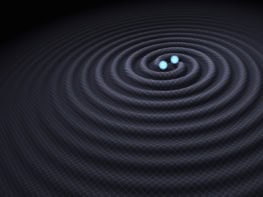
Physicists are drawing up plans to dismantle two of the largest experiments at the Gran Sasso National Laboratory in central Italy. The experiments, known as Borexino and the Large Volume Detector (LVD), are both used to detect neutrinos but require large amounts of organic compounds to do so – chemicals that environmentalists claim threaten the safety of local water supplies.
The laboratory is located next to a motorway tunnel under the Gran Sasso mountain chain between the towns of L’Aquila and Teramo. Operated by the National Institute for Nuclear Physics (INFN), it is home to several experiments studying neutrinos, dark matter and other rare sub-atomic phenomena. Because the lab lies under 1400 m of rock, it is shielded from cosmic rays. However, it also sits in the middle of an aquifer that supplies water to several hundred thousand local residents. Concerns over contamination of the aquifer were raised two years ago after small quantities of chemicals were accidentally released within the lab and ended up in the drinking water.
I understand that the scientists want to do their experiments but they aren’t in an ivory tower, they are in a society
Augusto De Sanctis
In September last year, prosecutors from Teramo charged four lab heads – including INFN president Fernando Ferroni and lab director Stefano Ragazzi – with endangering water supplies. Part of the lab had already been temporarily sealed off by a judge in Teramo in 2003 following the accidental spillage of 50 litres of the hydrocarbon pseudocumene from Borexino a year earlier. Now, Ferroni and colleagues are accused of defying a 2006 law that forbids the storage of dangerous substances within 200 m of drinking water sources, by failing to remove Borexino’s 1300 tonnes of pseudocumene and LVD’s 1000 tonnes of white spirit.
Prosecutors have still to declare whether they would like the indicted to stand trial. Meanwhile, Gran Sasso bosses are establishing what needs to be done to properly isolate experiments from the aquifer. These measures are likely to include sealing the lab’s floors and walls as well as overhauling the drainage system – work that was started following the 2002 leak but never finished. It is also part of a broader plan being overseen by the Abruzzo regional government that includes refurbishing the motorway tunnels and modernising the aqueducts that carry water out of the mountain.
A race against time
In November, the INFN awarded contracts to the Rome-based engineering company Ramboll to develop plans to decommission and dismantle of both Borexino and LVD. Then at a meeting the following month of a committee set up to coordinate the various works inside the mountain, the regional government presented a draft resolution – due to be approved by the end of January – stating that the decommissioning work should be completed no later than the end of 2019. INFN engineer Stefano Gazzana responded by asking that the deadline be pushed back to the end of 2020 – in part, according to Abruzzo government official Sabrina Di Giuseppe, to satisfy commitments given to institutions from other countries working on the experiments.
Former Borexino spokesperson Gianpaolo Bellini of the University of Milan says it is likely to take “a few months” to carry out the delicate operation of draining and dismantling the experiment. But he reckons that might still leave time for a significant discovery – observing neutrinos from the carbon–nitrogen–oxygen (CNO) cycle within the Sun – if the detector can run until 2020. Having to shut down the experiment by the end of 2019, in contrast, would, he says, make such a measurement “almost impossible”.
I hope I am mistaken that the current controversies put off other groups from working there
Gianpaolo Bellini
Bellini says that Borexino’s miniscule levels of radioactive impurities make it unique in being able to measure very low energy (solar) neutrinos. He explains that these particles are far more abundant than those at higher energies, so their detection raises the odds of snaring neutrinos from the CNO cycle – which is thought to provide just 1% of the Sun’s energy (but far more in heavier stars). However, making a sighting will be a race against time, he points out, given the huge amounts of data needed to spot these events above residual radioactivity within the nylon vessel used to hold the scintillating pseudocumene. Controversial Italian neutrino experiment gains support online
Bellini adds that he does not know of any plans for other detectors to fill the space to be freed up by Borexino and LVD. Indeed, he worries that researchers with ideas for new underground experiments will now avoid Gran Sasso. “I predict, but I hope I am mistaken,” he says, “that the current controversies put off other groups from working there”.
However, Augusto De Sanctis, president of the environmental group Abruzzo Ornithological Station, who filed the complaint that led to the current legal action, insists that the lab should lose no time in removing the chemicals. “That material can’t stay there, by law,” he says. “I understand that the scientists want to do their experiments but they aren’t in an ivory tower, they are in a society.”



